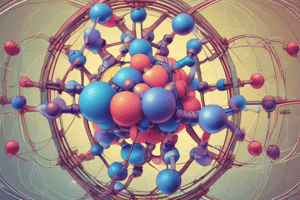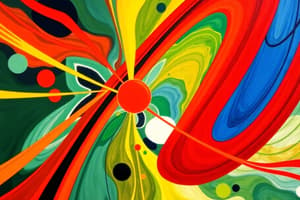Podcast
Questions and Answers
What is the melting point?
What is the melting point?
- The temperature at which a solid turns into a gas
- The temperature at which a liquid turns into a gas
- The temperature at which a solid melts to form a liquid (correct)
- The temperature at which a gas condenses to form a liquid
How can the purity of a substance be determined using heating and cooling curves?
How can the purity of a substance be determined using heating and cooling curves?
- By measuring the volume of the substance
- By checking if the melting and boiling points remain constant (correct)
- By measuring the density of the substance
- By observing the color change of the substance
Which of the following correctly describes a heating curve?
Which of the following correctly describes a heating curve?
- A graph showing temperature vs. time for a gas being cooled
- A graph showing temperature vs. time for a solid being heated (correct)
- A graph showing temperature vs. time for a liquid being cooled
- A graph showing mass vs. time for a solid being heated
What happens to the melting and boiling points of an impure substance?
What happens to the melting and boiling points of an impure substance?
What is the boiling point?
What is the boiling point?
Which of the following is true for a cooling curve?
Which of the following is true for a cooling curve?
What does a heating or cooling curve of a pure substance show?
What does a heating or cooling curve of a pure substance show?
During the melting phase of a pure substance, what happens to the temperature?
During the melting phase of a pure substance, what happens to the temperature?
What is the purpose of measuring the temperature at regular intervals in a heating curve experiment?
What is the purpose of measuring the temperature at regular intervals in a heating curve experiment?
Which phase change happens at the boiling point?
Which phase change happens at the boiling point?
Flashcards are hidden until you start studying
Study Notes
The Kinetic Theory of Matter
- Matter is anything that has mass and occupies space, composed of tiny particles (atoms, molecules, or ions) in constant motion due to kinetic energy.
- The amount of kinetic energy held in matter is determined by temperature and the state of matter (solid, liquid, or gas).
Diffusion
- Diffusion is the movement of particles from an area of high concentration to an area of low concentration, until the particles are evenly distributed.
- Occurs in both liquids and gases, resulting in a gradient of concentration.
Osmosis
- Osmosis is the movement of water particles from an area of high water concentration to an area of low water concentration, through a semipermeable membrane.
- Occurs in all living cells because water is needed for biological reactions and cell membranes are semi-permeable membranes.
Brownian Motion
- Brownian motion is the constant irregular motion of particles (e.g., pollen grains) floating on water, observed by Robert Brown in 1827.
- Explained by kinetic theory, where air and water particles constantly move and collide with heavier particles, causing them to move irregularly.
States of Matter
- Matter can be divided into three main states: solids, liquids, and gases, with a recently proposed fourth state called plasma (at high temperatures).
- Properties of solids, liquids, and gases are summarized in Table 1.1, showing their differences in volume, shape, and compressibility.
Solid State
- Particles are close together in an orderly fashion, with strong forces of attraction between particles, limiting movement to vibrating around a fixed point.
Liquid State
- Particles are further apart than in a solid, with less orderly arrangement, and weaker forces of attraction between particles, allowing particles to slip slowly over each other.
Gas State
- Particles are very far apart, with random arrangement, and very weak forces of attraction between particles, allowing particles to move freely in all directions at high speeds.
Sublimation
- Sublimation is the process of a solid changing directly into a gas without turning into a liquid first, e.g., dry ice, iodine, and ammonium chloride.
Transitions between States
- Melting: a solid changes into a liquid by gaining heat energy.
- Freezing: a liquid changes into a solid by losing heat energy.
- Boiling or Evaporation: a liquid changes into a gas by gaining heat energy.
- Condensation: a gas changes into a liquid by losing heat energy.
- Sublimation: a solid changes directly into a gas by gaining heat energy.
Heating and Cooling Curves
- Heating curves are obtained by measuring the temperature of a solid at regular intervals as it is heated.
- Cooling curves are obtained by measuring the temperature of a gas as it is cooled.
- Melting point is the temperature at which a solid melts to form a liquid or a liquid freezes to form a solid.
- Boiling point is the temperature at which a liquid boils to form a gas or a gas condenses to form a liquid.
Studying That Suits You
Use AI to generate personalized quizzes and flashcards to suit your learning preferences.




